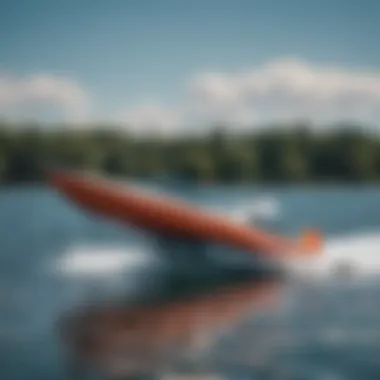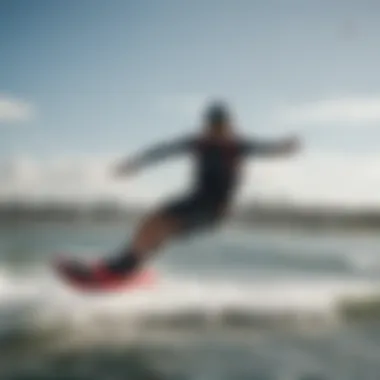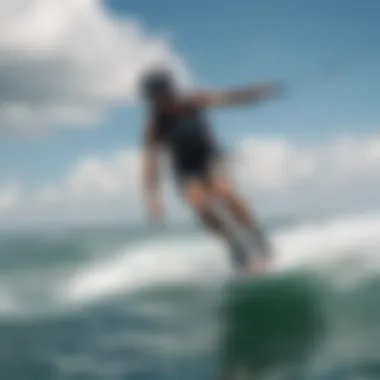Clearwater Hydrofoil: Design, Performance, and Impact


Intro
In the fast-evolving landscape of kiteboarding, Clearwater Hydrofoil has carved a unique niche, combining technology with the thrill that enthusiasts crave. This dynamic apparatus elevates the kiteboarding experience to new heights—literally. By lifting the rider above the water's surface, it reduces drag significantly, allowing for smoother rides and faster speeds. This article aims to demystify the Clearwater Hydrofoil, examining its sophisticated design, performance advantages, necessary maintenance, and its burgeoning influence within the kiteboarding community.
Whether you're a newbie keen to carve your first waves or a seasoned kiteboarder eager to push your limits, understanding the subtleties of hydrofoil technology is essential. Here, we will delve into what makes Clearwater Hydrofoil so compelling and essential in the sport today. So, buckle up as we travel through the intricacies of gear selection, skill development, and the environmental impact of this captivating innovation.
Prologue to Clearwater Hydrofoil
The Clearwater Hydrofoil represents a significant leap forward in the evolution of kiteboarding. As more enthusiasts and professionals embrace this technology, it's essential to understand not only how it operates but also its impact on the sport. As kiteboarding continues to capture the interest of many, Clearwater Hydrofoil stands out due to its innovative features, promising riders greater control and performance on the water.
Defining Hydrofoiling
Hydrofoiling is not merely about riding a board; it involves utilizing a submerged wing to lift above the surface of the water. The result is an exhilarating sensation of gliding, with reduced drag and improved speed. When the board reaches sufficient speed, the hydrofoil lifts the rider up, allowing them to skim over waves instead of cutting through them. This arrangement offers a new perspective on wind and waves, turning each ride into an experience that's both engaging and efficient.
The hydrofoil setup usually consists of a mast, a wing, and a fuselage. The effectiveness of this combination boils down to design. Different shapes and sizes can significantly impact performance, meaning riders often need to experiment with various configurations to find their perfect match. In essence, hydrofoiling transforms the act of kiteboarding, making it a unique task that requires both skill and understanding of the mechanics at play.
The Evolution of Hydrofoils in Kiteboarding
The journey of hydrofoils in kiteboarding can be traced back several decades. Originally emerging in the realm of sailing, hydrofoiling has seen its evolution closely intertwined with advancements in materials and technology. Early designs were often cumbersome and restrictive, but modern engineering has leveraged lightweight materials like carbon fiber, allowing for faster and more agile boards.
The advent of kiteboarding in the 1990s brought hydrofoils into yet another light. During this time, enthusiasts started to experiment with various wing designs, seeking to harness the power of the wind more effectively. As a result, competitions began to incorporate hydrofoil races, showcasing the unique dynamics set forth by these innovations. Today, riders can marvel at a high-speed ride, buoyed above the water, with mere finesse guiding their direction.
Mechanics of Clearwater Hydrofoil
Understanding the mechanics of Clearwater Hydrofoil is crucial for anyone looking to make the most out of their kiteboarding experience. It’s not just about gliding gracefully above the water; it's about grasping the underlying principles that enable such performance. The mechanics of hydrofoils delve into how they operate, the forces at play, and how these elements coalesce to create a fluid, efficient ride. A solid grasp of these principles can greatly enhance both novice and seasoned rider's skills, as well as inform essential maintenance practices to extend the life of their equipment.
How Hydrofoils Work
At the core of hydrofoiling technology is the principle that allows these devices to lift above the water's surface. A hydrofoil itself resembles an underwater wing, enabling the rider to glide with minimal drag. When a rider accelerates, water moves over the wing-shaped hydrofoil. This movement creates a pressure difference; lower pressure forms on the top side while higher pressure exists on the bottom side. As a result, lift is generated, and the board rises above the water.
In simple terms, imagine riding a bike uphill and the effort it takes. It requires pedaling harder to gain that upward momentum. Conversely, a hydrofoil does the opposite – it takes skilled navigation and the right kite settings to exploit wind currents efficiently.
A few key elements to consider include:
- Angle of Attack: The angle at which the hydrofoil meets the water directly affects lift. A steeper angle can generate more lift but may also lead to stalling, where the board drops back into the water.
- Speed: Increased speed typically leads to more lift, so the rider must gauge their velocity carefully to maintain balance and control.
- Weight and Balance: The rider's positioning on the board can influence the hydrofoil’s performance. Leaning too far back might cause a plunge, while being too far forward risks nosediving.
Being attuned to these mechanics allows riders to not only enhance their performance but also to appreciate the finesse of maneuvering a hydrofoil through various conditions.
Hydrodynamics and Performance
The hydrodynamics at play within hydrofoiling can be both fascinating and complex. The interaction of the board, foil, and water creates varying outcomes regarding speed and stability. Simply put, hydrodynamics explores how water flows around objects, and this understanding can dictate a rider's performance.
When considering performance, a few crucial factors come into play:
- Lift-to-Drag Ratio: Ideally, riders want the highest lift with the lowest amount of drag. A well-designed hydrofoil maximizes this ratio, allowing for smoother rides and speed without excessive effort.
- Speed Stability: Once airborne, maintaining stability without constant adjustments is essential. The right hydrofoil minimizes the turbulence caused by water surface interactions, providing a more consistent trajectory.
- Turning Dynamics: Hydrodynamics also influence how the hydrofoil handles turns. A design that allows for quick, smooth transitions can give a rider much-needed precision during aggressive maneuvers or competitions.
"The balance of avoiding turbulence while maximizing lift and control is the sweet spot every rider aims for."
As kiteboarders tackle different water conditions, understanding these hydrodynamic principles becomes even more pertinent. Flat, calm waters demand different considerations than choppy seas, and having a firm grip on the mechanics ensures riders make informed decisions that enhance their overall experience. Thriving in unique environments requires a blend of skill and knowledge – so having a command of the hydrofoil's mechanics is indispensable.
Design Specifications
In the world of Clearwater Hydrofoil, design specifications play a crucial role in shaping the overall performance and roadworthiness of the equipment. Each aspect—from the materials used to the outlines and dimensions—carries its own weight in the kiteboarding experience. Understanding these specifications allows riders to make informed decisions, ensuring that they select hydrofoils that meet their unique needs while also enhancing their on-water experience.
Material Composition
The materials used in constructing a hydrofoil profoundly influence its weight, strength, and corrosion resistance. Typically, hydrofoils are made from a blend of materials including fiberglass, carbon fiber, and aluminum.
- Carbon Fiber: This exceptionally lightweight material offers impressive stiffness and durability. Carbon fiber hydrofoils glide through the water with minimal resistance, making them a favorite for experienced riders seeking speed and agility.
- Fiberglass: Known for its toughness and flexibility, fiberglass hydrofoils are generally heavier but can absorb shocks better. They are suitable for beginners who may take a few spills before mastering their technique.
- Aluminum: Many entry-level hydrofoils utilize aluminum for its balance of price and performance. While not as light as carbon fiber, aluminum foils tend to be durable and can handle the rigors of learning without breaking the bank.


Ultimately, choosing the right material hinges on factors such as rider experience, style preferences, and budget constraints.
Shapes and Sizes
Shape and size specifications are not just about aesthetics; they are vital to dictating how a hydrofoil interacts with the water. Different outlines can enhance lift and stability, making understanding these shapes essential for any serious kiteboarder.
- Foil Shape: The shape of the mast and wings affects how well a hydrofoil slices through the water. Wider wings provide more lift and stability, which can help in choppy conditions. Conversely, narrower wings may allow for faster speeds but can become tricky for beginners.
- Wing Area: Larger wing areas contribute to increased lift, enabling riders to get up and moving quicker. However, larger wings can lead to increased drag at higher speeds, potentially limiting maximum velocity.
- Mast Length: The length of the mast determines how high the rider can rise above the water’s surface. A taller mast provides better clearance over waves but may feel less stable for novice riders who are still getting their footing.
In considering these specifications, riders can tailor their hydrofoil to suit their specific conditions, riding style, and personal comfort levels. Selecting the right combination of materials, shapes, and sizes can help unlock the full potential of one’s riding experience.
"Choosing the right hydrofoil is like picking the right pair of shoes. It must fit just right to allow for comfort while enabling you to dance through the waves."
Understanding these design specifications is not just technical knowledge; it's about creating a balanced, enjoyable experience out on the water. Whether you're a seasoned competitor or a weekend warrior, the right design will significantly impact your time on the board.
Performance Advantages
Performance advantages of the Clearwater Hydrofoil are critical for riders who wish to elevate their kiteboarding experience. These benefits do not merely enhance speed, but also offer a more controlled and efficient ride. Analyzing the intricacies of this performance reveals how hydrofoiling becomes a game-changer in the water sports industry. Below, we break down the core elements: speed and efficiency, and stability and control.
Speed and Efficiency
Speed is the name of the game when it comes to kiteboarding. With Clearwater Hydrofoil, riders can experience significantly higher velocities compared to traditional boards. This increased speed is primarily due to the foils that lift the board out of the water, reducing drag.
- Reduction in drag: When the hydrofoil lifts the rider above the water, the resistance is noticeably decreased, allowing for quicker acceleration.
- Wind utilization: The design of the hydrofoil allows users to harness the wind better, optimizing the kite’s power and turning it into forward motion more efficiently.
- Longer rides: For those looking for stamina, hydrofoiling lets riders glide along for extended periods. Without the wetted surface area created by traditional boards, the energy spent is diminished, resulting in less fatigue.
This distinct advantage comes into play especially during competitive seasons when every fraction of a second counts. Riders adopting the Clearwater Hydrofoil can set themselves apart on the course.
Stability and Control
Stability and control are equally paramount when riding a hydrofoil. Unlike traditional setups, Clearwater Hydrofoil offers a unique balance between agility and steadiness, crucial for riders navigating turbulent waters.
- Lower center of gravity: The design of the hydrofoil keeps the rider low, providing a solid base that increases balance in uneven conditions. This trait is particularly essential during wind gusts that can easily throw off a rider’s game.
- Responsive maneuvering: The connection of the foil to the board allows for sharp turns and quick adjustments, enabling users to respond to sudden changes in wind or currents. The need to frequently reposition a kite is less daunting when your platform possesses this level of responsiveness.
- Reduced bounce and splash: Hydrofoiling minimizes the up-and-down motion that traditional boards encounter. Riders can maintain a smoother ride, which translates into better focus on technique and performance.
"Hydrofoiling isn't just about speed—it's about commanding the water with stability and finesse."
Overall, the performance advantages of Clearwater Hydrofoil equip riders with tools to enhance their kiteboarding experience. Speed and efficiency, alongside stability and control, set this technology apart. While some may see hydrofoiling as merely a trend, understanding its intrinsic benefits can turn casual enthusiasts into skilled veterans in the sport.
Learning Curve for Riders
Understanding the learning curve for Clearwater Hydrofoil is vital not just for those new to the sport, but also for seasoned kiteboarders eager to enhance their skills. Hydrofoiling offers a unique and thrilling experience; however, beginners need to navigate several intricacies. This section will break down the essential points that pertain to starting out with hydrofoils, as well as progressing in skills and techniques.
Starting with Clearwater Hydrofoil
When stepping into hydrofoiling, one may feel as if they’re attempting to ride a wave while juggling flaming torches. The initial stages can be a tad overwhelming. Yet, with proper guidance, the journey can become smoother.
Choosing the Right Gear
Starting off, picking the proper equipment is essential. The Clearwater Hydrofoil comes in various sizes and shapes, adapting to different skill levels and conditions. A novice might opt for a larger foil, which provides more stability and buoyancy, making it easier to stay on top of the water.
Understanding Balance
Balance is the name of the game. Riders must learn to shift their weight properly. Initially, it feels like trying to equilibrate on a seesaw where one side keeps wanting to dip. Thus, practicing on flat water before tackling waves allows for smooth adjustments in weight distribution.
Basic Maneuvers
- Get Comfortable: Start by simply gliding on the board, allowing yourself to feel the ride without lifting off.
- Take Off: Gradually increase speed to lift the foil out of the water. Keep a steady pace, allowing yourself to build confidence.
- Learn to Fall: Falling is part of the learning process. Embrace it, and work on getting back on the board again.
"Every master was once a beginner. Embrace the process, and don't be afraid to fall."
Progressing Skills and Techniques
As you become more adept, the skills start piling up, like bricks stacked neatly in a row. Progression in hydrofoiling is not just about increasing speed; it’s about mastering control and precision.
Advanced Maneuvers
Once balance becomes routine, it’s time to work on more advanced tricks. Things like carving, pumping, and jumping become sought-after skills. Riders often find that progressing their techniques spurs a new appreciation for hydrofoiling. Familiarizing oneself with these techniques entails:
- Carving: This adds an element of style to your ride. Learning to carve will enhance turns without losing speed or balance.
- Pumping: This technique keeps the foil flying after riding the wave. It requires rhythm and timing, much like dancing.
- Jumping: Going airborne is exhilarating but requires both proper timing and technique.


Learning from Others
Connecting with more experienced riders can accelerate the learning process. Observing a pro can demystify complex maneuvers. Joining local groups or participating in clubs can provide insights and tips. Online platforms, such as Reddit and Facebook, offer communities where riders share their experiences and advice.
Personal Reflection
Finally, regular self-reflection on your progress can also enhance your learning process. Maintaining a journal to document achievements or areas where improvements are needed may offer surprising benefits.
Overall, learning to ride the Clearwater Hydrofoil is a progressive experience. From grappling with balance to executing advanced maneuvers, every step taken not only polishes your skills but also enriches your experience in kiteboarding. A commitment to practice indeed paves the path for mastery.
Maintenance Considerations
Maintaining a Clearwater Hydrofoil is like tending to a garden; a little effort goes a long way in ensuring longevity and performance. Regular maintenance not only enhances your hydrofoil's lifespan but also significantly improves your overall experience on the water. Let’s dive into key areas that deserve your attention to keep your gear in top shape.
Cleaning and Care
After a thrilling day of riding the waves, the last thing on most kiteboarders' minds is cleaning. However, neglecting this simple task leads to a buildup of salt, sand, and other debris that can compromise the hydrofoil's materials and mechanics.
Here are some practical steps for effective cleaning and care:
- Rinse with Fresh Water: As soon as you're back on dry land, give your hydrofoil a good rinse with fresh water. This quick action helps wash away salt that is known to corrode metal parts. Salt can be extremely damaging, so don't let it settle.
- Use Mild Detergent: For areas with stubborn dirt, a mild soap works wonders. Avoid harsh chemicals, as they may harm your foil’s finish. A soft cloth or sponge will work best.
- Dry Completely: After cleaning, make sure everything is thoroughly dried before storage. Moisture can lead to rust and other wear.
Managing these cleaning tasks may take a bit of time, but think of it as an investment into the quality and performance of your hydrofoil. A well-cared-for hydrofoil not only rides better but feels more responsive, enhancing your kiteboarding experience.
Identifying Wear and Tear
Like any piece of equipment, your Clearwater Hydrofoil will experience wear and tear over time. Being able to identify the signs early can save you from unexpected issues down the line. If not addressed, wear can compromise performance and even safety while riding.
Here are some signs to look out for:
- Scratches and Dents: Check your hydrofoil’s surface regularly. Even small scratches can lead to bigger problems if they reach deeper layers.
- Loose Connectors: Ensure the screws or bolts holding the hydrofoil together remain tight. If you notice anything loose, get a wrench or screwdriver to fix it ASAP.
- Surface Discoloration: Any changes in color, especially on metal components, might indicate corrosion. A simple inspection can help you catch these issues early.
- Wobbling: If you feel a wobble while riding that wasn't there before, it's time to assess your hydrofoil's integrity.
Remember, regular inspections should be part of your overall maintenance routine. Catching these concerns early means you'll continue to enjoy smooth rides and avoid potentially dangerous situations on the water.
"A stitch in time saves nine; the less you put off your maintenance, the more you will enjoy your hydrofoil."
By setting a maintenance schedule that includes cleaning and thorough checks for wear, you can ensure that your Clearwater Hydrofoil serves you well, wave after wave.
Hydrofoil in Competitive Kiteboarding
As kiteboarding evolves, hydrofoils play an ever-increasing role in competitive environments. The unique design of hydrofoils allows boarders to lift above the water's surface, significantly enhancing speed and maneuverability. This not only elevates the rider's experience but, crucially, transforms the dynamics of racing and tricks in competitions. With hydrofoils becoming a mainstay in competitive events, it is essential to understand their implications.
A notable benefit of hydrofoils is the ability to achieve greater speeds with less effort. Riders experience less drag, similar to how a bird soars effortlessly through the air. This efficiency can be advantageous in competition settings, where seconds can make all the difference. Moreover, being elevated means that riders can navigate through rougher tides and choppy waters, which can pose significant challenges for traditional boards.
Current Trends in Events
Recent events have showcased a marked shift towards hydrofoiling. Competitions such as the Hydrofoil World Tour illustrate this evolving trend, where multiple countries host events focused solely on hydrofoil kiteboarding. Riders are now pushing the boundaries of what is possible—performing complex tricks that seemed impractical with older designs. This trend is gaining traction not only among professionals but also within the wider kiteboarding community.
- Key Elements in Current Trends:
- Dedicated Competitions: More events are emerging that center on hydrofoil-specific formats.
- Rider Diversity: Entries now include a broader range of skill levels, promoting interest among newcomers.
- Technological Integration: Many riders are employing advanced tracking systems for performance analytics and workshops aimed at improving skills.
These developments indicate a vibrant future for hydrofoiling within competitive kiteboarding.
Influences on Kiteboarding Competitions
The incorporation of hydrofoils in competitions has painted a new image for the sport itself. With the growing popularity, there's a noticeable push towards developing specialized rules and formats that cater to hydrofoil riders. For example, judges are placing emphasis on speed and technique rather than just the amplitude of jumps, showcasing a shift in what defines a winning performance.
- Significant Influences Include:
- Performance Metrics: New benchmarks for scoring concerning speed and execution have emerged, reflecting hydrofoil characteristics.
- Media Exposure: Hydrofoil events are gaining more visibility via social channels like Reddit and Facebook, which in turn nurtures interest in the sport.
- Community Involvement: Local and national level competitions are springing up, serving as breeding grounds for talent and innovation in hydrofoil kiteboarding.
Through these lenses, one can see how hydrofoiling is not merely an accessory to kiteboarding; it has morphed into a pivotal element of competitive dynamics, enriching both the sport and the community surrounding it.
Environmental Implications of Hydrofoiling


The relevance of environmental implications in the conversation about hydrofoiling cannot be overstated. As kiteboarding enthusiasts increasingly embrace Clearwater Hydrofoil, understanding its environmental footprint is crucial. This involves looking at how hydrofoiling practices can support sustainability and positively influence marine ecosystems. Additionally, analyzing potential harmful effects—if any—can help riders make informed choices that align with their passion for nature and sports.
Sustainable Practices in Kiteboarding
When it comes to sustainability, kiteboarders have started to lean into more eco-friendly practices. These initiatives are not merely a trend; they are becoming a part of the culture within the kiteboarding community. Riders are increasingly encouraged to minimize their environmental footprint, keeping in mind both their equipment and their practices.
A few examples include:
- Using eco-friendly materials: Many manufacturers are shifting to sustainable materials like recycled plastics and organic fibers to produce hydrofoils and kites, reducing waste and energy use.
- Supporting responsible brands: Riders are becoming discerning consumers, opting for brands committed to sustainable practices in their production and supply chains.
- Promoting local kiteboarding spots: Instead of traveling extensively, community events often emphasize staying local, which not only lessens travel-related emissions but also fosters a deeper connection with local waters.
Riders are becoming increasingly aware that their choices—big or small—can have a monumental impact on the environment. By incorporating sustainable practices, individuals can contribute positively to preserving the beautiful waters they enjoy.
Impact on Marine Ecology
Shifting our gaze to marine ecology, it's imperative to consider the effect of hydrofoiling activities on underwater ecosystems. On one hand, hydrofoiling might seem innocent enough; after all, it doesn’t require a motor, reducing noise pollution and emissions. However, the interaction between humans, water, and wildlife must be examined, especially near sensitive habitats.
Some key points regarding its impact are:
- Wildlife Disturbance: Fast-moving boards can disturb marine life during critical times, like breeding or feeding. Avoiding areas populated with wildlife can reduce this disruption.
- Erosion and Habitat Changes: Setting up equipment on shorelines can potentially lead to disturbances in sediment, which may harm corals and underwater habitats over time.
- Pollution Management: Proper disposal of gear and equipment care can prevent toxic materials from entering the water. Using eco-friendly cleaning products can also help preserve the quality of marine environments.
"Minimal impact, maximum adventure." — This embodies the ethos many riders adopt. Balancing our passion with environmental empathy is essential for ensuring that our playground remains pristine for generations to come.
Community and Culture Surrounding Hydrofoiling
The world of hydrofoiling is not merely a sport; it’s a vibrant community bonded by a shared passion for the water and innovation. This section investigates how different facets of the hydrofoiling community and culture impact enthusiasts and the sport itself. The activities, gatherings, and digital interactions each contribute to a unique tapestry that defines what it means to be a hydrofoiler today.
Gatherings and Events
In the realm of hydrofoiling, gatherings and events shine as pivotal moments for learning and camaraderie. From small local meet-ups to renowned competitions, these occasions foster a sense of belonging among riders. Everyone from beginners to veterans engages in sharing insights, tips, and techniques.
Some notable highlights of these events include:
- Competitions: Highly anticipated competitions not only showcase talent but also incentivize improvement and innovation in hydrofoil design and techniques. Participants often experience an adrenaline rush, and spectators enjoy witnessing incredible feats of skill.
- Workshops: Many events also feature workshops led by experienced riders, aimed at teaching newcomers fundamental skills or offering advanced riders guidance to refine their abilities.
- Community Building: Beyond the competitive edge, these gatherings enhance connections between fellow enthusiasts, thus strengthening the community. Friends are made, stories are exchanged, and lifelong bonds are formed under the sun and surf.
Influence of Social Media
Social media has undeniably changed the game in every corner of life, and hydrofoiling stands not exempt from this trend. Platforms like Instagram and Facebook have revolutionized how riders share their experiences and knowledge. From posting breathtaking photos of aerial maneuvers to vibrant discussions in dedicated Facebook groups, social media acts as both a showcase and a sounding board.
- Sharing Accomplishments: Riders take pride in sharing their latest achievements or groundbreaking moves, allowing others to celebrate alongside them, even from miles away. It fosters motivation among peers, inspiring them to push their limits and try new techniques.
- Building Networks: Aspiring riders and experienced professionals can connect easily, discussing gear setups, local conditions, or travel tips, truly making the globe feel smaller.
- Promoting Events: Stay in the loop with all upcoming gatherings and competitions. Social media channels are vital for disseminating information about local competitions, workshops, or community clean-up events, enhancing participation and engagement.
"Social media connects us in ways the ocean's vast expanse cannot separate us."
In summary, the community and culture surrounding hydrofoiling play a critical role in shaping the sport. From connecting enthusiasts through face-to-face events to facilitating dialogue in the digital space, these elements enhance the overall experience of hydrofoiling. By documenting progress and sharing achievements, riders forge a collective journey, cultivating growth for themselves and for the sport.
Future of Clearwater Hydrofoil
As we venture into the future of Clearwater Hydrofoil, the horizon looks promising and filled with potential. This section emphasizes why understanding future trends is crucial for both avid kiteboarders and those involved in the industry. The advancements anticipated will not only enhance performance and safety but will also better integrate hydrofoiling into the broader context of water sports and environmental sustainability.
Technological Advancements on the Horizon
Technological progress is often the backbone of any sport's growth, and hydrofoiling is no exception. The industry continues to focus on enhancing experience through innovation. Below are some notable advancements expected to redefine performance:
- Smart Materials: The use of composite materials which provide lighter weight and better flex characteristics. A promising direction is seen in carbon fiber technologies, making boards not only lighter but also more durable and efficient.
- Integrated Sensors: Devices that can monitor rider performance, optimizing for proper balance and technique in real-time. Imagine having a system giving continuous feedback on speed, lift, and even environmental conditions.
- Advanced Manufacturing Techniques: Technologies such as 3D printing are emerging, allowing for more intricate designs that can improve hydrodynamic efficiency and personalization options for individual users.
These advancements foster an environment where both novice and experienced riders can elevate their skill levels and enjoy the sport more deeply.
Potential Innovations in Design
Design is constantly evolving in kiteboarding, with a keen focus on adaptability to varying conditions and rider preferences. This section discusses the innovative design elements gearing up to take the spotlight in the near future:
- Modular Designs: Kiteboarders are starting to see boards that allow for easy swapping of components. This flexibility could mean different foils can be attached or customized based on the conditions of the day.
- Eco-Friendly Materials: With a growing focus on sustainability, new materials derived from recycled plastics or bio-based composites are likely to be introduced. This change will reflect a conscious effort to diminish the sport's carbon footprint.
- Ergonomic Shapes: Boards designed with rider comfort in mind, taking into account the way a rider stands and maneuvers. This might shape into new contours that reduce drag and improve lift for a smoother ride.
All these elements indicate a shift towards a more versatile, sustainable, and rider-focused future in Clearwater Hydrofoil. As the kiteboarding community embraces these changes, enthusiasts will find themselves navigating the waters with even greater confidence and enjoyment.
"The future belongs to those who believe in the beauty of their dreams."
As we look at these advancements, it becomes clear that both the design and technology will change the hydrofoiling experience in profound ways, emphasizing speed, safety, and sustainability. Kiteboarding is not just a sport; it's about the evolution and connection with nature.















